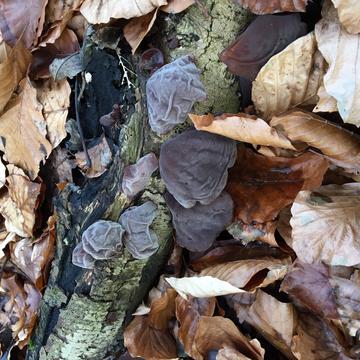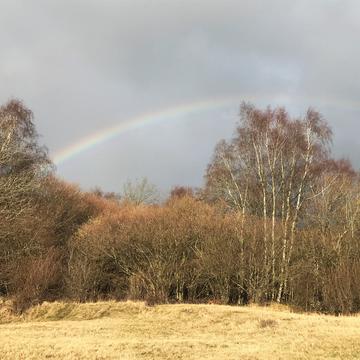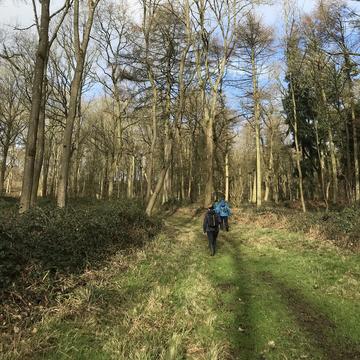The Woods in Winter
The Woods in Winter
Keith Kirby led us on a most interesting ramble through the history of the woods, taking in its setting; the origins of Brogden’s Belt; the tussle between ecology and forestry in which the Dead Wood Beetle appears to have had the casting vote in favour of a non-interventionist approach to managing the woods; the different plantings that have taken place, from the oldest part forested since Medieval times, the conifer and hardwood plantations of the 19th and 20th Centuries and the current challenges faces by potential loss of 2-3ha ash stands to dieback. We visited the trenches excavated to train soldiers in the First World War on Radbrook Common and the beech stands that have grown over them since, complete with the promise of bluebells. We passed the duck pond being reinstated and extended and admired a rainbow cast over the chalet as we headed to lunch. We spent the afternoon exploring our morning’s walk and experiences through poetry, both writing it and through the words of Robert Frost, Alice Oswald and others.
- Romola Parish
About Romola Parish, collaborating on the Woodland Words 2019-20 project with Sarah Watkinson
Romola Parish is a poet, artist and harpist. She was poet in residence at Oxfordshire County Council’s Historic Landscape Classification Project and author of two collections: In Polygonia, a collection of poetry about the landscape around Stonesfield, and Crying in the Silicon Wilderness, a collection of poetry and meditations accompanying an exhibition of textile art. Her inspiration comes form landscape in all its forms and meanings. She is a former archaeologist, academic and currently a planning and environment lawyer in London. She is also undertaking a PhD focussed on St Frideswide, Patron Saint of Oxford.
A selection of poems written by the attendees:

Wytham Fungus
Thick fleshy forest fungus
With the gentle velvet folds of a newborn mammal
Creased and wrinkled
Mink brown, mouse’s back
Bloomed with white
A woodland oyster fanning its soft grooves to a scalloped edge
A living cockleshell for the Wytham pilgrim
Vanessa
The Found Walking Stick
Damp, too heavy, not a pleasing shape, uncomfortable in my hand,
But the wood I picked up freed me from fear of slipping.
Moving on, I rejoiced in the colour and forest shapes around me.
Walk over, I laid my ugly useful staff down, then took a photo.
Later, I idly spread my fingers on the screen
And into focus came a beautiful sight -
A silvery scalloped edge against dark, ridged wood
A patch of pale turquoise lichen, like scrunched leaves.
Absorbed by the beauty all around me
I had missed the beauty walking with me.
Barbara Phillips
The Woods of Hazel

(for Hazel ffennell)
In the woods of hazel
by this singing way
we here pray.
Though we may hack the crowns you saved
axe to the very core the copse you once laid,
we shall remember,
though we may hew the cross you bore
fell the very wood to fuel our fires of war
foment our very own final curtain’s fall
and force the very shoots to spring no more,
we shall recall
Though we pollute your rain and poison your earth
cause here under the thresh of your flailing boughs
to wither now our flesh in your thrawn branches,
whilst in the wind your limbs creak, grate and screech:
too late? too late?
yet still does Man its own widow maker
blow by blow by blow by blow
here create
Though we succour for profit and loss our forest of greed
suck to the last drop the very life’s sap we need,
with each attack of Man’s cudgelling
act upon act upon act upon act yet
between each crack in the deadfall heart of every tree,
in the dwindling shivelight of Man’s dying dominion
does your memory
still here bleed
this testament for hope
this legacy for life
this ledger of Man's indenture
this account of debts unpaid
to nature, here laid
In the woods of hazel
by this singing way
we here do pray.
Garry Maguire
Wytham Coppice in January
We notice in the woods ahead a pink flush

in the tree tops, walk closer to look,
hear from our guide that this is a coppiced bank
of sweet chestnuts, grown in the past
for their straight poles, for hops perhaps -
while providing dense undergrowth for wildlife
plus now, a plot of forest management style
for student to learn these olden ways.
We debate the trees' lineage: native, or introduced?
There’s evidence, says our escort, through folklore
and place names of a pre-Roman presence.
I am reminded of childhood, and autumn
visits to the sandy soiled chestnut woods,
near the Devil’s Spadeful where we would
forage for the spiky cases, which we’d stamp on
to reveal the treasure within. We’d take home
pocketfuls of them to roast on the open fire
impatient for the sweet delicacy inside those
tough brown skins.
Sarah Bryson



